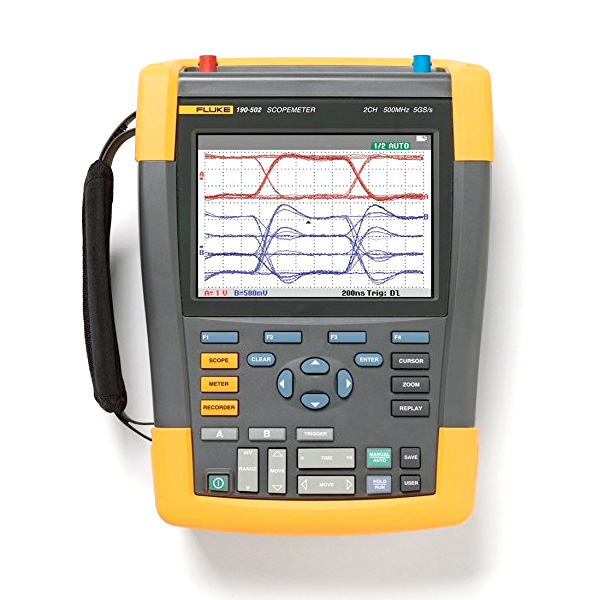Shop
Fluke 190-502/S Color ScopeMeter, 500 MHz, 2 Channels Plus DMM/Ext.Input with Software & Carrying Case
Description
- Handheld unit combines a two-channel digital oscilloscope for viewing electrical signals with a digital multimeter for measuring voltage and resistance
- Real-time sample rate is 625Ms/s for 60MHz models, 1.25GS/s for 100MHz models, 2.5GS/s for 200MHz models, and 5GS/s for 500MHz models, and record length is 10,000 points per channel for acquiring detailed waveforms
- Zoom function, three math functions plus FFT, and automatic and cursor measurements for analyzing waveforms
- 6″ color LCD shows up to four readings or waveforms simultaneously
- Meets EN and IEC 61010-1:2001 and 61010-031:2002+A1:2008, ANSI/ISA 61010-1 (82.02.01), and CAN/CSA C22.2 61010-1-04 safety standards, and is rated CAT III installations to 1,000V and CAT IV installations to 600V
The Fluke ScopeMeter 190 series is a handheld electrical test device that combines a two-channel digital oscilloscope for viewing electrical signals with a manual- and auto-ranging digital multimeter for measuring AC and DC voltage to 1,000V, AC/DC voltage to 1,000V true RMS, and resistance to 30MΩ. The unit can also measure power for single- and three-phase systems, displaying the total power (watts), apparent power (VA), reactive power (VAR), and the power factor (PF) to determine how efficiently an installation uses power. The oscilloscope has a real-time sample rate of 625Ms/s for 60MHz models, 1.25GS/s for 100MHz models, 2.5GS/s for 200MHz models, and 5GS/s for 500MHz models, and a record length of 10,000 points per channel for acquiring detailed waveforms. A zoom function magnifies waveforms up to x100, three math functions—add, subtract, and multiply—plus FFT (fast fourier transform), and automatic and cursor measurements allow an in-depth analysis of waveforms. Edge, pulse width, video, and N-cycle (burst) triggers allow isolation of specific signals. The oscilloscope’s advanced automatic triggering recognizes signal patterns and automatically optimizes triggering, timebase and amplitude settings. To aid debugging, the pass/fail testing compares a live waveform to a reference waveform and can be set to store either waveforms that match (pass) or do not match (fail) the reference waveform. The 5,000-count multimeter has two ranging modes: manual, which allows the user to select the operating range, and auto, which automatically selects the appropriate operating range. The relative function allows a measurement to be set as a reference value and displays subsequent measurements as a positive or negative deviation from that value, and the data-hold function freezes a reading on the display to aid documentation. A continuity buzzer confirms that the circuit conducts electricity, and a diode check detects whether a circuit’s diodes are working properly. The unit automatically stores the 100 most recent screens in its internal memory which can be accessed by the replay function. Additionally, the oscilloscope has a recorder that captures from 6 seconds to 48 hours of waveforms and stores up to 30,000 data points per channel. Its TrendPlot chart function graphs the minimum, maximum, and average readings over time from 60 minutes at 5 seconds per division to 22 days at 30 minutes per division. Include a rise time of 5.8ns for the 60MHz models, 3.5ns for the 100MHz models, 1.7ns for the 200MHz models, and 0.7ns for 500MHz models, and various triggering features. The unit has a 6″ (53 mm) color LCD with a resolution of 320 x 240 pixels for viewing waveforms and measurements, and an LED backlight for visibility in low light. It can display up to four readings or waveforms simultaneously. A multimeter is an electrical testing tool for measuring multiple properties of an electrical circuit to verify proper operation or diagnose problems.




